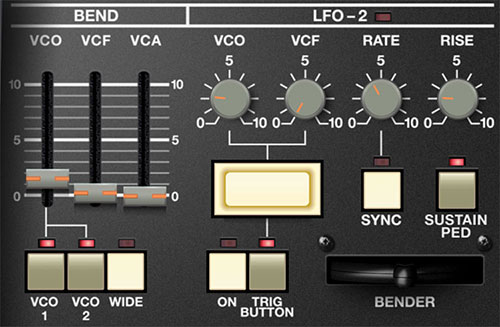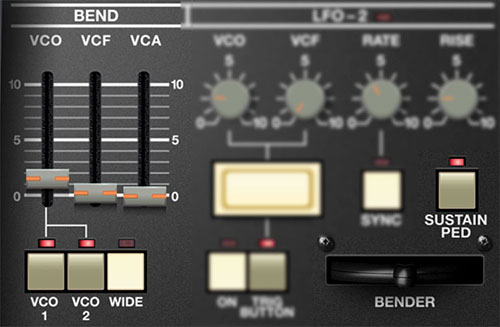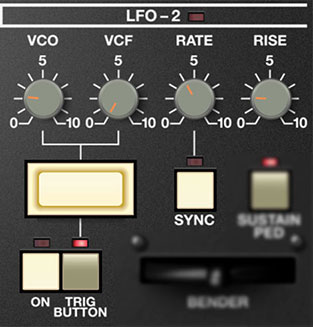
These are the controls to the left of the virtual keyboard. These affect how Mercury-6 responds to incoming pitch bend (the Jupiter-6's pitch bend joystick could affect more than just pitch) and sustain pedal control messages; it's also where LFO-2 lives.
Bend

The original instrument had a joystick bender control that moved on a horizontal axis, plus large on/off button for initiating modulation. Roland made up for the lack of a variable mod control with a clever joystick implementation that allowed the joystick to control VCO pitch, VCF cutoff, and VCA volume.
VCO- Sets maximum bend pitch bend depth for both oscillators.
VCO 1/VCO 2- Selects which oscillator receives pitch bend. This is nice if you'd like the bender to affect only one of the oscillators.
Wide- This overrides the VCO range slider setting and sets the bend range to 40 semitones (yes, I had to play the keyboard chromatically and count). We're not sure what the original designers had in mind with this feature, but you can make some serious bender racket by enabling the VCO 1 destination button (but not VCO 2) and turning up the Cross Mod section Manual slider.
VCF- Sets maximum filter cutoff mod depth. Moving the pitch bender down reduces the cutoff frequency; moving it up increases cutoff frequency.
VCA- Sets maximum VCA mod depth. Moving the pitch bender down reduces VCA amplitude; moving it up increases VCA amplitude. In other words, it's like having volume control via the pitch bender.
(We're gonna scoot around a little here in order to keep all LFO-2-related controls together)
Bender- The onscreen pitch bender can be moved with a mouse and follows the movement of incoming pitch bend data. Mainly, it just looks cool.
Sustain Pedal- This toggles incoming sustain pedal control data. It's mainly useful for split or layered patches where you'd like one layer to respond to the sustain pedal and one layer to ignore it. Handy for sustained spooky low drone notes.
LFO-2

On the original instrument, LFO-2 was "performance only," that is, the only way to activate it was to press (and hold) the big button. We've increased LFO-2's usefulness by allowing user selection of standard trigger button activation or always-on mode.
On/Trigger Button-
On- LFO-2 constantly runs, with its amount set by the VCO and VCF knobs.
Trig Button- LFO-2 only runs when the rectangular momentary LFO-2 Mod Trigger button is pressed.
If you're using Trig Button mode, remember that it's super easy to assign a hardware button controller by right-clicking and choosing MIDI Learn (more about this in the MIDI Controllers Setup and The MIDI Tab section).
LFO-2 Mod Trigger Button- This guy isn't labeled, but pressing it momentarily enables LFO-2 when Trig Button mode is enabled.
VCO- Sets LFO-2 mod depth for both oscillators.
VCF- Sets LFO-2 mod depth for filter cutoff.
Rate- The Rate knob sets the speed of the LFO, from 0.04 to 11.5 Hz (with Sync button off) or from 8 beats up to 1/64th note triplets (Sync button on). The LED above the Rate slider flashes at the current modulation rate.
Sync- When the Sync button is enabled, LFO-2 speed will lock to host tempo when using Mercury-6 within DAW software, or to the current tempo in the top menu bar when using the standalone version.
Rise- Turning the Rise knob up gradually delays the onset of LFO-2 depth. The delay time can be set from 50 to 1000 milliseconds - note that there's always a little bit of delay. Keep in mind that like the original, there's only one LFO-2 per layer, so LFO-2 always affects all voices equally.